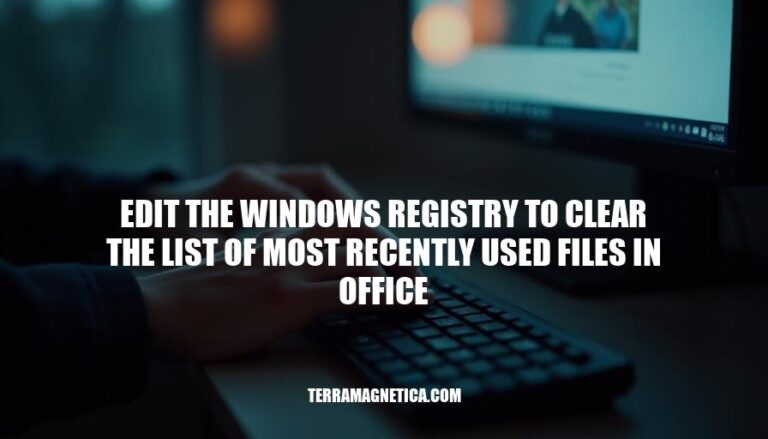


Editing the Windows registry to clear the list of most recently used (MRU) files in Microsoft Office is a powerful method to enhance both privacy and system organization. The MRU list, which appears in various Office applications, provides quick access to recently opened files. However, this convenience can also pose privacy risks, as it allows others to see which documents have been accessed.
By modifying specific registry entries, users can effectively remove these traces, ensuring that sensitive information remains confidential. This action not only protects privacy but also helps in maintaining a clutter-free and organized system, making it easier to manage and locate important files without the distraction of outdated or irrelevant entries.
The Windows Registry is a hierarchical database that stores low-level settings for the Windows operating system and for applications that opt to use the registry. The Registry keeps information, settings, options, and other values for programs and hardware installed on all versions of Microsoft Windows. It plays a vital role in managing user preferences and system configurations, including settings for applications, user-specific configurations, device settings, and security.
For example, the registry maintains the list of most recently used files in Microsoft Office applications, allowing for quick access and personalized user experiences. It serves as a central repository for configuration data, which allows the system to access and retrieve it quickly, ensuring a seamless user experience.
Press the Windows key + R to open the Run dialog box. Type regedit and press Enter. If prompted by User Account Control, click Yes to open the Registry Editor.
In the Registry Editor, navigate through the registry tree using the following path:
HKEY_LOCAL_MACHINE.SOFTWARE.Microsoft.Office.You will now be in the Office keys section of the registry.
To locate the specific registry entries related to the list of most recently used (MRU) files in Office applications, follow these paths:
Word: HKEY_CURRENT_USER\Software\Microsoft\Office\[version]\Word\File MRU
Excel: HKEY_CURRENT_USER\Software\Microsoft\Office\[version]\Excel\File MRU
PowerPoint: HKEY_CURRENT_USER\Software\Microsoft\Office\[version]\PowerPoint\File MRU
Replace [version] with the version number of your Office installation (e.g., 16.0 for Office 2016).
Open the Registry Editor: Press Win + R to open the Run dialog box, type regedit, and press Enter.
Navigate to the MRU List: Go to HKEY_CURRENT_USER\Software\Microsoft\Office\<Office Version>\Common\Recent Docs.
Delete the MRU List: Right-click on the Recent Docs folder, select Delete, and confirm the deletion.
Close the Registry Editor: Click OK to close the Registry Editor.
Warnings: Modifying the Windows Registry can cause serious system issues, including instability, application errors, and even making the system unbootable. Always create a backup before making changes.
Backup Instructions:
Open the Registry Editor.
Click on File > Export.
Choose a location, name the file, and save it as a .reg file.
To restore, open the Registry Editor, click File > Import, select the backup file, and click Open.
Proceed with caution and ensure you understand the risks involved.
Edit the Windows Registry to clear the list of most recently used (MRU) files in Microsoft Office enhances both privacy and system organization by removing sensitive information from being accessed by others, while also maintaining a clutter-free and organized system.
However, it is crucial to follow the steps carefully to avoid any unintended system issues, as modifying the registry can cause serious problems such as instability, application errors, or even making the system unbootable.
It is essential to create a backup before making changes to ensure that you can restore the original settings if needed.